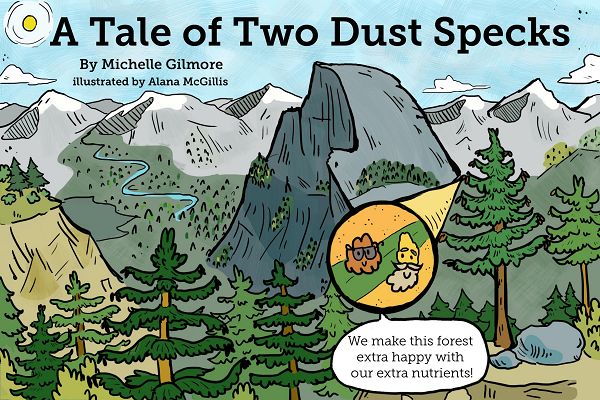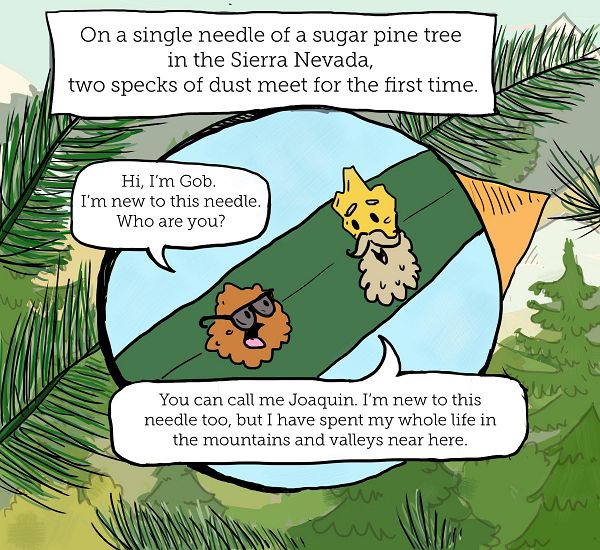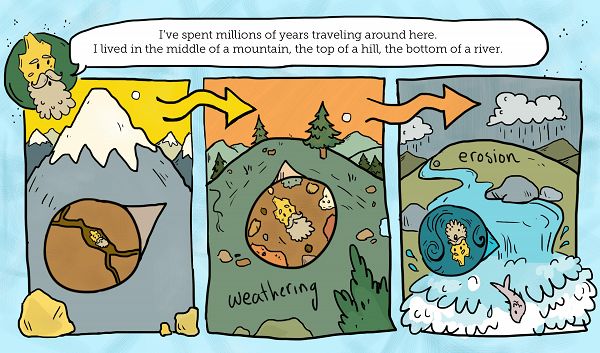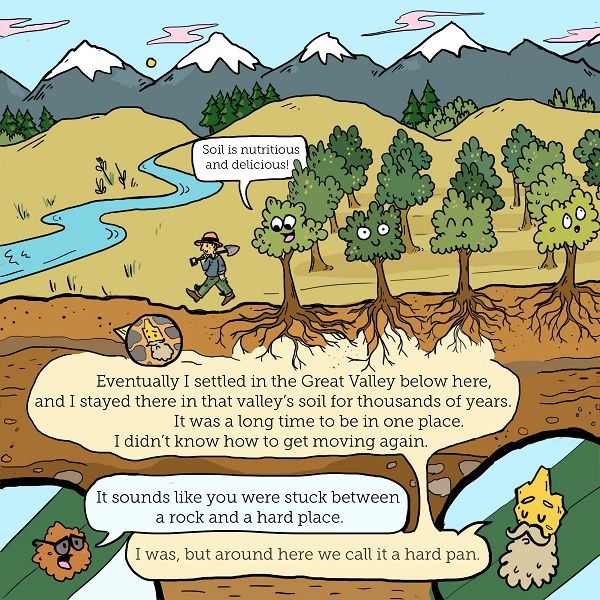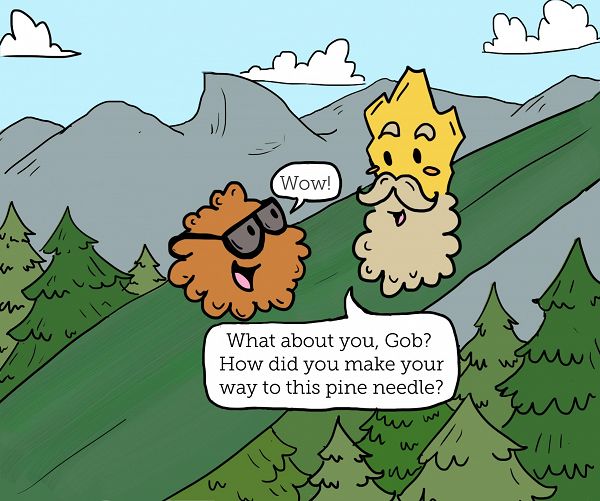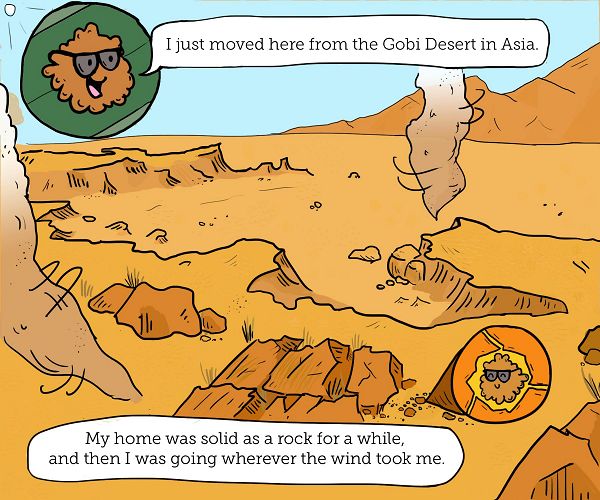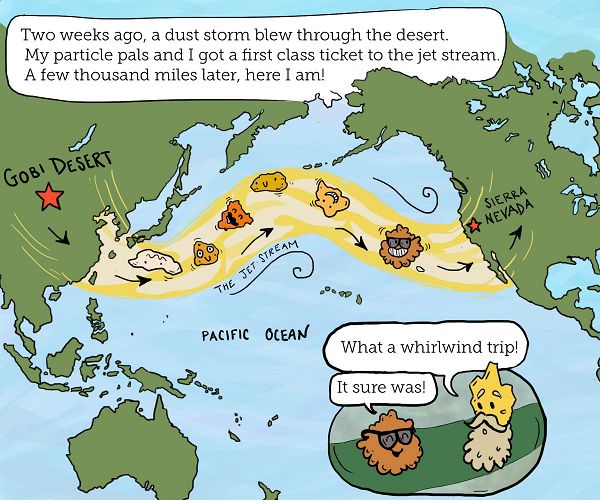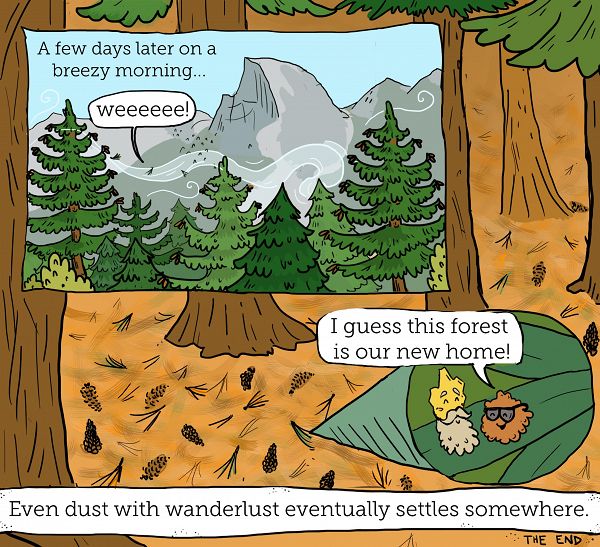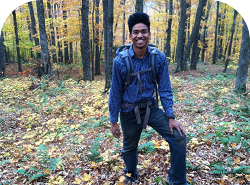Jan 08, 2018
This comic is based on research conducted by critical zone scientists Sarah Aciego, Emma Aronson, Lindsay Arvin, Stephen Hart, Clifford Riebe, and others. They found that dust provides important nutrients like phosphorus to Sierra Nevada ecosystems, often more nutrients than the granitic bedrock provides. Most of the dust in the Sierra Nevada comes from the Central Valley of California and the Gobi Desert in Asia. Dust particles are incorporated into soil and eventually taken up by the vegetation growing in that soil. Their results show that dust can play a major role in ecosystems across the world. As climate and land use change with time, dust will continue to impact ecosystems in the future. The researchers’ findings were published in two papers in 2017 (Aciego et al. and Arvin et al.).
Download a printable version of this comic (10MB PDF). Each page is sized as half of a legal page so it can be printed as a mini-booklet.
Created by Michelle Gilmore
Illustrated by Alana McGillis
Panel 1. A sunny view of Yosemite Valley with Half Dome and pine trees. A close up of a tree branch shows two friendly looking dust specks. Both say "We make this forest extra happy with our extra nutrients!"
Panel 2. Both dust specks sit on a single needle of a sugar pine tree in the Sierra Nevada. Gob, a rounded speck with glasses, says “Hi, I’m Gob. I’m new to this needle. Who are you?” To which, Joaquin, a jagged speck with a mustache and beard, replies: “You can call me Joaquin. I’m new to this needle too, but I have spent my whole life in the mountains and valleys near here.”
Panel 3. Joaquin continues, “I’ve spent millions of years traveling around here. I lived in the middle of a mountain, the top of a hill, the bottom of a river.” Joaquin sits in a rock fracture, weathers down a hill and floats in a river.
Panel 4. He continues to say, “Eventually I settled in the Great Valley below here, and I stayed there in that valley’s soil for thousands of years. It was a long time to be in one place. I didn’t know how to get moving again.” Gob chimes in, “It sounds like you were stuck between a rock and a hard place.” Joaquin agrees and says, “I was, but around here we call it a hard pan.”
Panel 5. But Joaquin found a way out! He says, “A couple of days ago, a giant tiller rolled over the soil I was living in. It mixed everything up, and suddenly I was dust in the wind, free as a bird. I rode the wind up here and landed on this needle.”
Panel 6. “Wow!” exclaims Gob as they sit upon the pine needle. Joaquin then asks, “What about you, Gob? How did you make your way to this pine needle?”
Panel 7. Gob is shown in a rock fracture and responds, “I just moved here from the Gobi Desert in Asia. My home was solid as a rock for a while and then I was going wherever the wind took me.”
Panel 8. A map shows dust particles moving from the Gobi Desert in Asia across the Pacific Ocean to the Sierra Nevada Mountains in the western U.S. Gob continues, “Two weeks ago, a dust storm blew through the desert. My particle pals and I got a first class ticket to the jet stream. A few thousand miles later, here I am!” Joaquin exclaims, “What a whirlwind trip!” Gob replies, “It sure was!”
Panel 9. A few days later on a breezy morning, the pine needle with Gob and Joaquin blew to the forest floor. Gob says, “I guess this forest is our new home!” Even dust with wanderlust eventually settles somewhere. The End.
Files
A Tale of Two Dust Specks
(10 MB pdf)
Printable version of this comic. Each page is sized as half of a legal page so it can be printed as a mini-booklet.

Michelle E. Gilmore
CZO STAFF. Outreach Manager. Specialty: multi-audience outreach, mentored field studies, landscape evolution, environmental geochemistry
CZO Profile | Twitter - SSCZOFacebook - SSCZOInstagram - NSF Critical Zone Observatory Network
Outreach / Education Research EDUCATION/OUTREACH General Public K-12 Education Higher Education
COMMENT ON "Adventures in the Critical Zone"
All comments are moderated. If you want to comment without logging in, select either the "Start/Join the discussion" box or a "Reply" link, then "Name", and finally, "I'd rather post as a guest" checkbox.
ABOUT THIS BLOG
Justin Richardson and his guests answer questions about the Critical Zone, synthesize CZ research, and meet folks working at the CZ observatories
YOU MAY LIKE
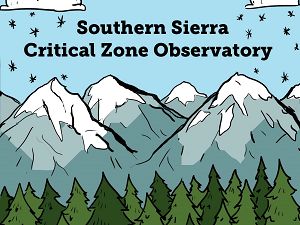
What is the Southern Sierra CZO?
An illustrated introduction to the Southern Sierra Critical Zone Observatory! By Dr. Justin Richardson and Michelle Gilmore Illustrated by Alana...
Justin Richardson
General Disclaimer: Any opinions, findings, conclusions or recommendations presented in the above blog post are only those of the blog author and do not necessarily reflect the views of the U.S. CZO National Program or the National Science Foundation. For official information about NSF, visit www.nsf.gov.
Explore Further

